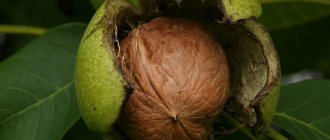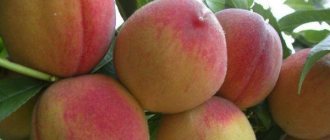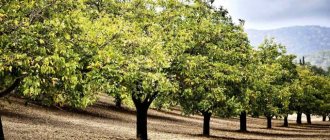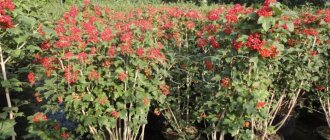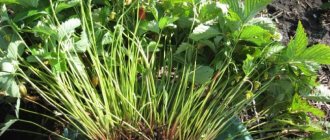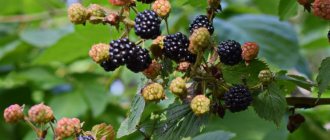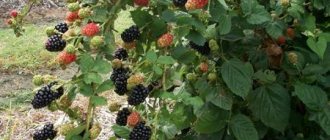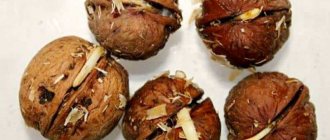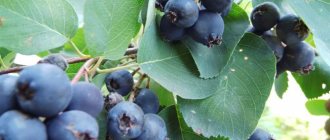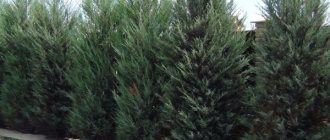Do walnuts grow in the Moscow region?
Moscow (the Moscow region is conventionally called the Moscow Region) climate is temperate continental. Seasonality is clearly expressed. It's warm here in summer, cold in winter. In the eastern and southeastern regions, continentality is more pronounced. This is manifested by higher temperatures in summer and very low temperatures in winter.
The period with an average daily temperature below 0°C lasts between 120–150 days. Snow usually falls in November and disappears in April. On average, in winter the temperature stays within -25°C; in rare years it can drop to -45°C, but for a short time. In summer, the average temperature is +25...+30°C, the highest is +39.5°C.
Taking into account the peculiarities of the climate, walnuts can be cultivated in the Moscow region, because they are quite hardy.
The roots of plants go deep underground, which protects them from freezing even in severe frosts. Nuts begin to bloom in May, and during this period it is already quite warm in the areas under consideration, so there is no risk of buds freezing due to return frosts.
During the long warm period, the fruits of the trees have time to fully ripen. The main thing is to choose the right variety. It is better to give preference to cold-resistant crops, which have been bred in sufficient quantities over many years of selection.
Did you know? The nutritional value of the protein contained in nuts is completely equal to that of dairy and animal products, and is also easier to digest by the body.
Shrub propagation
Walnut is an unpretentious, cold-resistant plant that grows best in temperate and mild climates. The tree has the ability to self-heal, as a result of which, instead of shoots that die in harsh winters, new ones almost always grow.
To learn how to plant a walnut correctly, you should familiarize yourself with the main methods of its propagation. You can spread this culture:
- seeds;
- seedlings;
- in a vegetative way.
When planting a seedling, it is quite difficult to predict what fruits it will bear in the future and whether they will be obtained. Therefore, growing from seeds is preferable, since about 80% of varietal characteristics are guaranteed to be transmitted. You should select nuts for planting from those trees that grow in your region.
If the mother plant is chosen correctly, growing walnuts vegetatively also ensures that the characteristics of the resulting offspring and the mother tree are identical. An effective method of such propagation is budding in open ground.
You can increase the number of shrubs on a site through propagation. The procedure is performed in various ways depending on the desired result, characteristics of the variety and environmental conditions.
The best varieties for the Moscow region
The best varieties of walnuts for cultivation in the Moscow region:
- Sadko is a dwarf variety. The height of an adult plant is 3.5 m. The tree enters the fruiting phase already 3 years after planting. The variety tolerates cold well. The fruits are formed in clusters of 6–8 pieces. Their shells are thin, making them easy to clean.
- Ideal - enters the fruiting phase already 2 years after planting. Withstands temperatures down to -35°C. The plant itself reaches 5 m in height. The harvest can be produced 2 times a year.
- Astakhovsky is a relatively new crop that has proven itself well when grown in the Moscow region. Tolerates frosts down to -37°C. Mature plants reach 10 m in height. They begin to bear fruit 6 years after planting.
- Fruitful - enters the fruiting phase 4 years after planting. Tolerates frosts well. The height of an adult plant reaches 6 m.
- Levina - tolerates frosts well down to -35°C. Plants begin to produce harvest 4 years after planting. The fruits are formed in clusters of 4–6 pieces. They are distinguished by a very thin shell, which is very easy to spread with your fingers.
Walnut - not from Greece
I went to the Internet to look for “northern” planting material. And thanks to him, I met passionate nut growers: Alexey Gorbunov and his friends have been successfully growing walnut and other nut seedlings on the border of the Moscow region and the Tula region for several years.
“Our most famous walnut,” says Alexey Gorbunov. — Everyone knows: the plant is southern, grows well in Central Asia, the Caucasus, and the Krasnodar Territory. Nevertheless, there are relatives of the walnut from the same family that can withstand frosts down to -50 degrees, and -44 quite calmly. But what's the catch?
The more frost-resistant the nut, the thicker the shell and the smaller the kernel. And, conversely, thin-barked nuts tolerate frost worse. Here, for example, is the Manchurian nut. Frost-resistant, tasty, but the kernel is small, you'll have a hard time picking it out. Black walnut is a very beautiful tree, and is also considered the most powerful in terms of medicinal properties. Gray walnut is also often planted in Moscow; it releases phytoncides and perfectly purifies the air.”
We invite you to familiarize yourself with Japanese Pieris: description, planting and care
And now about something that few people know yet: there is an excellent variety of walnut “Ideal”, adapted to our not at all southern conditions. Its wild predecessor was discovered during an expedition on the border of China and Kazakhstan in the foothills of the Tien Shan in the 60s. The trees were unusually compact - up to 5 meters.
“Ideal has three excellent qualities,” explains Alexey Gorbunov. — Wood can withstand up to -36. Kidneys up to -32. Even if the tree freezes slightly, in the spring it produces “whips” - powerful shoots and quickly recovers. The second quality is early pregnancy. It can produce nuts within 2-3 years after planting. The third advantage is that it is low growing: it is easy to grow and the fruits are easy to harvest. At the same time, our short summer is enough for the nuts to ripen. Our seedlings successfully bear fruit in Vyazma, the Moscow region, and near St. Petersburg.”
Planting in the ground in the Moscow region
Proper planting of walnuts in open ground is the key to good yield . This issue must be approached very seriously, given the large size of the plants. If you plan to grow several trees at once, you need to calculate the area. There should be a distance of at least 5 m between plants. If planting is carried out on slopes, then you can reduce the distance between trees to 3.5 m.
Selecting a location
For full growth and development, the nut needs a spacious, well-lit place . The level of lighting directly determines how the fruits of the plant will ripen. Shading will have a bad effect on the quality of the nuts - they will be small and tasteless. The culture does not like wetlands, so you should select an area where the groundwater level is no higher than 2 m.
Important! Walnuts should not be planted near outbuildings, fences or homes. Otherwise, the roots may destroy the foundation.
Trees will grow better in areas rich in humus, so it is imperative to properly prepare the soil for planting.
Soil preparation
Planting is best done in the spring. This will allow the seedlings to fully take root and prepare for the cold. They begin to prepare the soil in advance, in the fall. The area should first be cleared of plant debris. Then plow to a depth of 40 cm. After this, disinfection is carried out with copper sulfate. At this stage, use a 3% concentrate - add 300 g of powder to 10 liters of water. It takes 1 liter of the finished solution to process each m².
A week after disinfection, 30 kg of manure mixed with 6 tbsp. is applied to each m² of area. wood ash and 200 g of superphosphate. Immediately after this, re-cultivation is carried out to a depth of 30 cm. A week before planting, the area must be dug up to a depth of 20 cm. At this stage, 10 kg of compost per m² and 80 g of urea can be added to the soil.
Planting pit
Seating arrangement:
- Dig a hole measuring 40x40 cm.
- Place a sheet of plastic film on the bottom - this is necessary to stimulate the growth of lateral roots.
After the hole is prepared, the seedling is immersed in it and the roots are carefully straightened horizontally. Then they begin to cover them with soil one by one. It is important to ensure that the uppermost shoots of the rhizome are in the soil at a depth of 5–7 cm. As soon as all the manipulations are completed, the tree trunk circle is compacted with hands, and then the seedling is watered with 10 liters of water. After waiting for moisture to be absorbed, compost or peat is laid out around the trunk. The height of the mulch layer should be within 5 cm.
Preparing nuts before planting
Before planting, the fruits should be prepared. To do this, they are exposed to cold, water, and ultraviolet light. If the plant is planned to be planted in the spring, it is necessary to perform stratification.
To do this, the fruits should be immersed in a container with wet sand, and then taken to a place with a low temperature - 0-+5 degrees. This could be a basement or a refrigerator.
Stratification will take 3-4 months. Every 3-4 weeks, nuts should be removed and ventilated. At this point, it is recommended to moisten the sand. After stratification, the nut is placed back into the soil.
Also, before spring planting, the fruits can be placed for 1 month in a room with a temperature of less than +10 degrees. Then soak in a container of water at room temperature and leave for 2-5 days.
It is worth considering that only those fruits that have sunk to the bottom can be used for planting. Nuts remaining on the surface can be discarded.
After the specified time, only those fruits are removed from the container whose flaps have moved apart and a root has formed. To make it grow and become stronger, the nuts are placed in a container filled with wet sand or sawdust, after which it is taken out to a warm room. The temperature in it should be +25-28 degrees.
After 10 days, the roots will grow to 0.5-1 cm. When this happens, the containers are transferred to a cool place. They must be there until the crop is planted.
Both shelled and unshelled nuts are allowed to be grown. At the same time, the former exhibit faster germination. To clean the fruit, you should carefully remove the top shell. This must be done so as not to touch the inner layer.
It is worth considering that the manipulation should be carried out with gloves, otherwise the green layer will leave stains on the skin, which will be very difficult to get rid of.
If the inner shell is damaged, the nut will not be able to germinate or the sprout will become sick.
When planting in spring, nuts should be thoroughly dried. To do this, they are laid out horizontally in 1 layer and exposed to the sun for 2 days. Then the fruits are sent to a shaded place for 2-3 days. This will help dry them out. The use of special devices for drying is strictly prohibited.
If you plan to plant nuts at home in the fall, stratification is not required. Also, the fruits do not need to be germinated or dried.
Subtleties of care and ripening time
Growing walnuts is not at all a troublesome task. The culture is quite unpretentious in care. But at the initial stage, while the seedlings take root, you will have to put in more effort. The biggest advantage of cultivating these plants is that there is no need for formative pruning.
Watering
At first, watering should be done 2 times a month. Adult specimens are moistened much less frequently.
They will only need 4 waterings per year:
- before flowering;
- at the moment of fruit formation;
- in midsummer;
- after harvest.
Each plant requires an average of 30 liters of water. For young trees, 20 liters will be enough. Liquid is poured from a bucket under the root. After watering, a day later, it is necessary to loosen the soil to a depth of 3 cm.
Selection of fertilizer and feeding
Fertilizers are applied twice a season:
- in spring - before flowering;
- in the fall - after harvesting.
Rotted manure (10 kg per m² of tree trunk circle) is used as the first feeding Once every 3 years in the spring, the top 3–5 cm of soil should be replaced with a mixture of peat, manure and wood ash. The first 2 components are combined in a 1:1 ratio, ash is added within 20% of the total mass of the earth.
Important! The first time after planting, nuts begin to be fertilized a year after the start of fruiting.
In autumn, superphosphate is used. For an adult plant (from 7 years old) you will need 5–10 kg of the substance. It is dissolved in water for pre-winter watering. For young trees, 2.5–4 kg of superphosphate will be sufficient.
Mulching
In order for the soil to retain moisture well, it should be mulched. This manipulation also reduces the risk of fungal spores and pests spreading in the soil. Mulching is carried out after watering and loosening.
As mulch, you can use a 1:1 mixture of peat and sand, compost or just green freshly cut grass . The layer of mulch is not changed, but added about 2 cm each time. This approach will allow you to additionally fertilize the soil - after loosening, part of the mulch will go into the deeper layers of the soil and rot there.
Preparing for winter
There is no need to cover trees for the winter. After harvesting, you should trim off broken and dried branches. Then water and fertilize as described above. After this, loosen the soil and mulch it. You can increase the mulch layer to 10 cm. After this, the trunk should be whitened with lime to a height of 1 m.
Choosing a nut fruit
The process of growing a plant directly depends on the quality of planting material. The fruit must be fresh. Do not use nuts that have been dried or heat treated. It is worth considering that old nuts germinate much worse.
Therefore, you need to buy fruits for planting in September. You shouldn’t buy store-bought nuts because you can’t be sure of their freshness and lack of processing. The ideal solution would be nuts that were collected yourself.
It is important that the fruit is ripe. It should not have stains or damaged areas. The shell should be quite thin. To grow a crop from a fruit, it is necessary to select the largest specimens.
Before planting, you should try the nuts from the collected batch. They must have excellent taste. When choosing a variety, you should give preference to those that grow in this area.
Collection and storage of fruits
They begin to harvest the fruits after the green pericarps begin to crack. They are removed from the branches by hand. You can also spread a blanket or tarpaulin under the tree and cover the fruit. After collection, you should keep the nuts in a dark room at a temperature of +6...+10°C for about a week.
Then the fruits are freed from the pericarp . To prevent the skin of your hands from turning black after cleaning, you should first wear rubber gloves. The shelled nuts are dried in the sun for about 3–5 days. Then they are placed in cardboard or plastic boxes. Store in a well-ventilated dry place.
Caring for seedlings at home
To get a powerful and viable plant, during the period of caring for walnuts you need to follow these recommendations:
- Culture needs excellent lighting. If a seedling is constantly in the shade, it can get sick and even die. Moreover, this will happen in the active growth phase.
- The plant needs systematic hydration. The nut should be watered constantly to avoid drying out the earthen coma. It is worth considering that the crop tolerates drought worse than excess moisture. However, it is also not recommended to try too hard. Otherwise, there is a risk of root rotting.
- In warm weather, the container with the plant should be taken out into fresh air. However, it is important to ensure that the seedling is not exposed to drafts. In hot weather, the container with the nut should be wrapped in a damp cloth. This will help avoid overheating of the root system. At high temperatures, the pot can be lowered into cool water.
- The soil under the plant should be mulched. For this, peat, moss, and rotted organic fertilizers are used. If necessary, the mulch should be updated.
- The nut needs to be fertilized with fertilizer. It should contain a lot of potassium. The procedure should be carried out every 2 weeks. The manipulation is carried out systematically while the crop is in the growing season.
When taking a seedling out into the open air, it is important to ensure that it is not exposed to pests or infectious diseases. The codling moth and garden aphid pose a great danger to the crop. You should also beware of American butterfly, root canker, and brown spot.
It is worth considering that culture is developing rapidly. This leads to the appearance of a spreading crown. To limit the size of a tree, you need to prune it. It takes 3-4 years to form the crown of a potted nut.
The first pruning is performed at 2 years. Starting from the 5th year, it is recommended to remove only weak and thin branches. They also get rid of shoots that grow vertically. The manipulation should be performed twice a year. Pruning is carried out in early spring and in the second half of autumn.
During the first 4 years of development, the tree must be planted annually in a new pot - it should be 8-10 cm larger than the previous one. At this time, you can renew the roots by removing old and rotten fragments. When the nut reaches 5 years of age, it can only be replanted once every 3-5 years. This is done by pouring new soil under the base of the trunk.
Pests and diseases
As a result of improper care, soil depletion or changes in climatic conditions (prolonged rains, intense heat, late spring frosts, etc.), walnuts can be affected by the following diseases:
- brown leaf spot - eliminated by spraying with 1% Bordeaux mixture concentrate at least 3 times with a break between manipulations of 10 days;
- bacterial burn - in the early stages it is treated with “ Fitolavin ” (use according to the instructions), in the later stages you will have to remove the diseased plant from the area;
- bacteriosis - the development of the fungus is stopped by treatment with a 3% solution of Bordeaux mixture in combination with 1% urea ;
- root cancer - manifested by the appearance of growths on the roots; usually the disease is identified late, so the plants have to be destroyed.
The most common pests that live on nuts are aphids, codling moths, American white butterflies and sapwood. When parasites appear, the lesions should be eliminated immediately by cutting off the damaged branches. Then carry out the treatment with “Bitoxibacillin” according to the instructions.
Did you know? Nut kernels contain magnesium. This causes a slight sedative and hypnotic effect, and also helps reduce the negative effects of stress on the human body.
Planting and growing a nut on your own plot in the Moscow region is not difficult even for a beginner in gardening. The trees require minimal care, are rarely affected by diseases and pests, and also produce a large harvest of healthy and tasty fruits.
Tips and tricks from experienced gardeners
In order to get a harvest and choose the right variety, you must follow the following recommendations to prevent possible problems:
- The nut has a developed root, so a distance of at least 2-3 meters must be maintained between two seedlings.
- Walnuts must be planted with pre-sprouted seeds or ready-made seedlings. This will reduce the risk of death of planting material and preserve the taste of the plant.
- For a small area, it is necessary to use low-growing plants that do not require care. The advantage of such plants is the simple harvesting process.
Ideal and Giant
The only downside to growing can be the lack of sun. Even with slight shading, this variety begins to weaken, the yield gradually decreases, and there is no need to talk about precociousness and large-fruitedness.
Based on this magnificent variety, an equally magnificent hybrid, the Giant, was obtained, which retains all the best characteristics of the “Ideal”, except for one – short stature. The giant is intensely drawn to the sun and grows to be a real giant up to 15-20 m. Highly productive and powerful, this nut will be an excellent addition to your chosen Ideal, especially since from one tree in 5-6 years you will be able to collect up to a hundredweight of large, beautiful, delicious fruits. The ideal keeping of these trees in a garden plot is in pairs.
Preparing for winter
In the middle zone and to the north, young walnut seedlings need insulation for the winter. To do this, the entire tree trunk circle at a distance of 50-70 cm from the seedling is covered with a layer of straw or hay (you can take bedding from rabbits, goats), dry horse manure, a layer of 15-20 cm.
Such a blanket will protect the roots from the cold, and in the spring it will feed the nut with nitrogen.
There is no need to whiten young nuts with lime. Its bark successfully resists burns.
Elena Chursinova A practical gardener with twenty years of experience. I prefer organic farming and lazy gardening. ...
